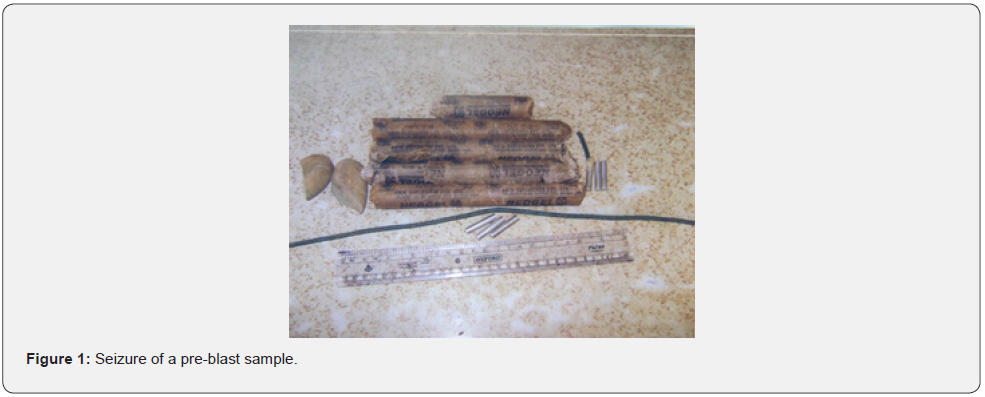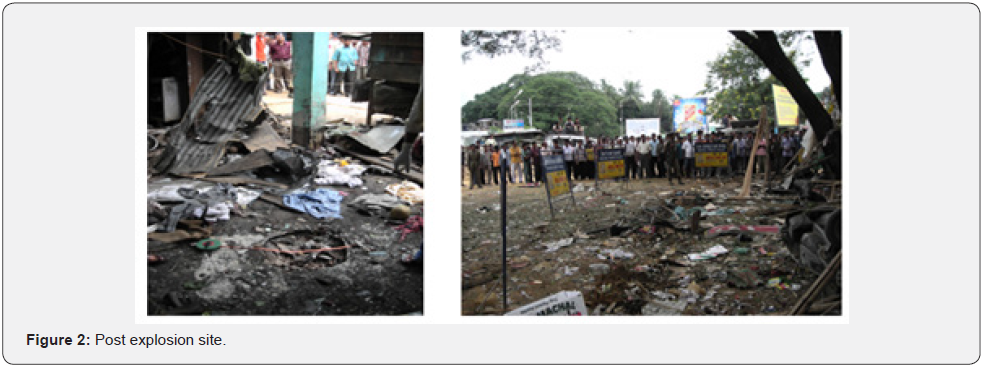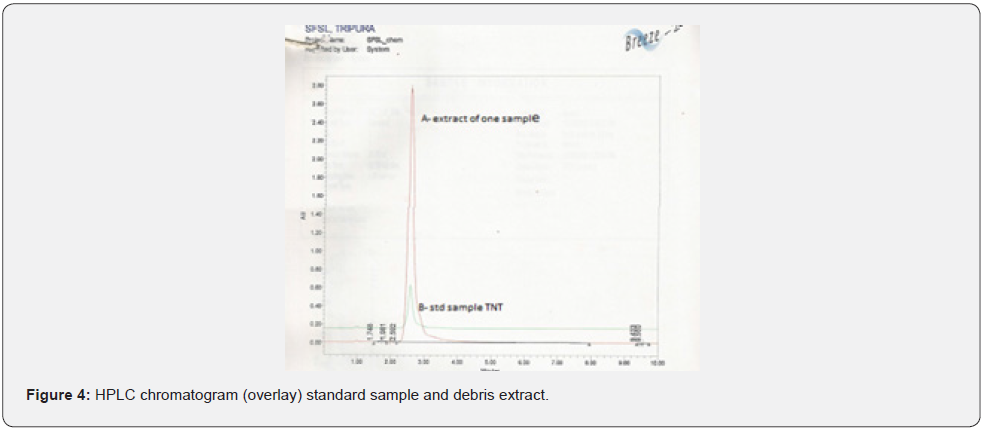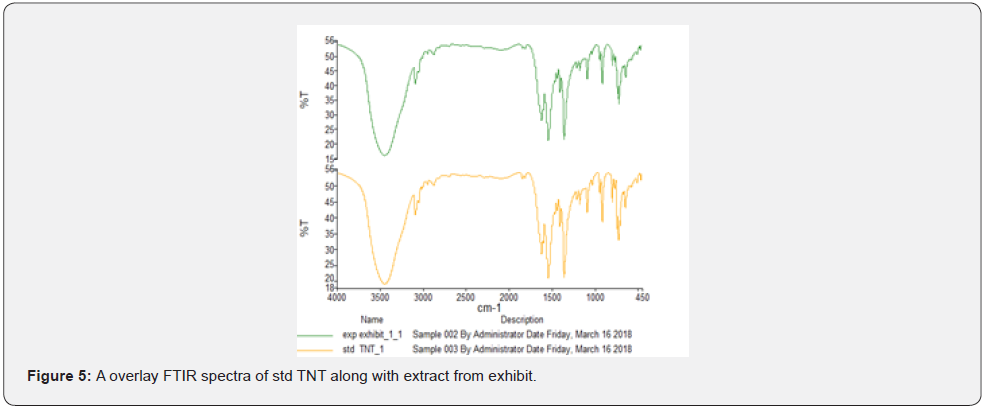Chromatographic Techniques and their Applications in Characterization of Trace Post Explosive Residues
SK Chakrabarti*, HK Pratihari and S Ghosh
Tripura State Forensic Science Laboratory, India
Submission:May 30, 2021;Published:June 16, 2021
*Corresponding author:SK Chakrabarti, Tripura State Forensic Science Laboratory, Narsingarh, Agartala-15, India
How to cite this article:Tahir J, Muhammad U, Zahid M, Imtiaz H, Abid N, et al. Detection of Chloroquine in Opium Using GC-MS: A Toxic Adulterant for Opium Abusers. J Forensic Sci & Criminal Inves. 2021; 15(3): 555911 DOI:10.19080/JFSCI.2021.15.555911.
Abstract
In most of the explosive cases, the post blast investigation of the scene is challenging to the scientists working in the field of forensic chemistry. The evidence analysis at the blast site is very complex and heterogeneous in nature. Moreover, the trace material available in the post blast site is contaminated with organic/inorganic substances with many other impurities. It requires proper separation to analyze the explosive components present in the post blast exhibits. In such situation, the chromatographic techniques are ideal for isolation and characterization of the post blast explosive residues. The Thin layer chromatography (TLC) and High-Performance Liquid Chromatography (HPLC) and Ion chromatography (IC) with different solvent system and visualization reagent are very much helpful to establish the identity both qualitatively & quantitatively to help the investigation. In addition to chromatographic studies, the spectrophotometric techniques are also further helpful to strengthen the results. The different post blast exhibits related to some cases, examined using state-of-the-art equipment for characterization of the trace quantity of post blast explosive residues, have been discussed in this paper.
Keywords: Post explosive residues; TLC; HPLC; TNT; Chromatography
Abbreviations: IED: Improvised Explosive Device; HPLC: High-Performance Liquid Chromatography; IC: Ion Chromatography; TLC: Thin Layer Chromatography
Introduction
The terrorists throughout the world use to widely rely on Improvised Explosive Device (IED)and sophisticated firearms in their activities to kill innocent people and achieve their goal. Their main activities are to attack armed forces to snatch firearms to strengthen their base and to spread terror among the people. As per available literature there are different terrorist groups working underground in different regions of the country. As per data from 2000 to 2010 a quite good number of civilians and security personnel have been killed and several firearms snatched.
The reason for use of IED are attributed for the following reasons.
1) Convenient to conceal and carry.
2) Ease of execution.
3) Cause more casualties in minimum time.
4) Create more fear psychosis.
5) Fog like condition produced creating poor visibility after explosion helping the terrorist to escape from the site.
Almost in all such explosive cases the forensic team use to visit the post blast site and different types of physical exhibits encountered during crime scene management are mentioned below:
a) Crater on the site, help to estimate the approx quantity of charge used.
b) Brick pebbles, loose soil, sand from inside/near the crater.
c) Scrapings of stains from immovable objects at the blast site
d) Iron and other different metallic pieces/stones used as sharpnels.
e) On/off switch/timer device chips and other trigger mechanism.
f) Molten and twisted metallic pieces.
g) Jute string, paper pieces.
h) Unidentified mass and debris mostly charred.
i) Burnt cloth from the site of explosion.
j) Pieces of single and multi-stranded wire.
k) Perforated and plain metallic sheets and wood pieces with switch mechanism.
l) Different shapes of glass/porcelain/plastic pieces.
m) Diffused detonator with/without wire.
n) Wearing apparel of the victim/dead body.
o) Burnt vegetables.
p) Shattered/deformed containers.
q) Hand wash /barrel swab/swab collected from immovable objects etc.
In addition to the above, other evidence are also observed depending on the seat of explosion and place.
Case report 1
In one case an IED was planted but fortunately before explosion it was detected and diffused by the bomb disposal squad. All the diffused materials were received for examination (Figure 1). The identification of the chemicals and to trigger the mechanism of the IED was comparatively easier in this case.

Case report 2
In this case several IED’s were planted in different places and successive explosions took place resulting in loss of life and property. The post explosive sites are shown in the (Figure 2). The relevant post explosive exhibits were collected for analysis to help the investigation.

Extraction Technique
Residues of parent compound after explosion are often trapped and fused into surrounding making the extraction task complex. Extraction of residues from debris by aqueous/organic solvent depend on their solubility factor.
The extraction from debris is done in different medium as detailed below.
i. Extraction by hot water.
ii. Extraction by alkali.
iii. Extraction with acetone.
iv. Extraction after sodium fusion for detection of elemental Sulphur.
The extract made by different media are concentrated and analyzed by different colorimetric reactions and instrumental analysis.
Chemical and Instrumental Analysis
Chemical
The extracts are first subjected to inorganic analysis for detection of inorganic ions that constitute to form an explosive mixture from extract no- 1, 2 & 3. Application of classical chemistry on the extract no- 1 & 2, for detection of different inorganic explosive ions and organic explosive residues e.g., RDX, TNT NG, etc. by colorimetric reactions [1-4]. Griess reagent, Nesslers reagent are useful for preliminary identification of RDX, PETN, TNT and ammonium ion, respectively. Further the chloride reagent, sulphate reagent, perchlorate reagent, peroxide reagents help in preliminary identification of respective ions. The inorganic ions can be further subjected to analysis by Ion Chromatography. Simultaneous detection of anions and cations in inorganic explosive residues by ion chromatography helps in reduction of analysis time and use of chemical [4,5]. The inorganic explosive residues are examined with extract-1 & 2 [6].
Instrumental analysis
The instrumental analyses of post explosive residues require sample preparation to avoid any damage to instrument. The sample without purification, should not be subjected to spectroscopic study. But in a chromatographic technique separation and identification can be carried out simultaneously. Comparison with a known standard are helpful for confirmatory results.
Thin Layer Chromatography (TLC)
Parameters for TLC study
a) Mobile phase-CHCl3:CH3COCH3(1:1)
b) Stationary phase-Pre coated Aluminum TLC plates.
c) Visualization reagent- 5% Diphenylamine in 95% Ethanol/UV light.
The TLC study can be further carried out with different solvent system and visualization reagents.
The organic samples are then subjected to analysis by High Performance Liquid Chromatography (HPLC), and Fourier Transform-Infra Red Spectroscopy (FT-IR), Gas Chromatography coupled with Mass Spectroscopy (GC-MS).
High Performance Liquid Chromatography (HPLC)
The HPLC chromatogram along with overlay display of standard sample reveals the success of the liquid chromatography (Figure 3-5).

Parameters
Detector – Waters 2487 Dual λ Absorbance, Column: Reverse Phase C-18 column, particle size - 5μm, size -4.6×10mm, Mode – Isocratic; Pump -Waters 1525Binary HPLC pump, Data Mode- Absorbance; Run time- 12-20 minutes, Mobile Phase-Acetonitrile: Water (70:30) [3]. Detection limit for debris -10ng, wavelength of UV- 210nm. Alternatively, separation from soil can also be achieved with 25cm×4.6mm, C-18 column(5μm) with mobile phase MeOH: H2O (50:50) at a flow rate of 1.5m/min, UV detector-254nm as nitro aromatic explosives absorbed strongly at this wavelength, whereas interferents like chlorinated organic compounds do not [5]. HPLC is preferred for debris analysis admixed with polar/nonpolar compounds and biological fluids like blood etc. Qualitative/quantitative analysis can also be done with a parallel run with standard samples.
Fourier Transfer Infra-Red
Make Perkin Elmer, Model - Spectrum Two.
Study of Gas Chromatograph (GC) coupled with Mass Spectrophotometer can also be done for analysis of post blast explosive residues. A mass spectrum of TNT is shown in (Figure 6).



Result and Discussion
The post explosive cases always present the forensic scientists a complex and difficult circumstances to investigate [7]. In the above-mentioned cases, the application of a combination of techniques could help to extract, analyses and characterize the explosive residues present in the exhibits to be Trinitrotoluene. The extraction and analysis techniques has evolved and changed a lot from conventional techniques to a safe green chemistry technology. A combination of different chromatographic methods was required in the post explosive cases for detection of residues of explosives from post blast samples. The successful investigation and detection of the explosive in the above case has helped the court of law beyond doubt for effective prosecution resulting in conviction of the prime accused persons.
Acknowledgement
a) The authors are thankful to the staff of chemistry division for extending technical support during analysis of the physical evidence in the cases.
References
- Huri MAM, Ahamed UK, Roliana O, Mustafa (2017) A review of explosive residue detection from forensic chemistry perspective. Malaysian J of Analytical Sciences 21(2): 267-282.
- Royds D, Lewis S, Taylor AM (2005) A case study in Forensic Chemistry-The Bali Bombings. Talanta 67(2): 262-268.
- Working procedure Manual on Explosives (2005) Directorate of Forensic Science, MHA, Govt of India.
- Yinon J, Zitrin S (1981) The Analysis of Explosives, Pergamon Press, New York, USA.
- Yinon J, Zitrin S (1993) Modern Methods and Application in Analysis of Explosives, John Wily and Sons, New York, USA.
- Alexander Beveridge (1998) Forensic Investigation of Explosions, Taylor, and Francis Ltd. Bristol.
- Yallop HJ (1980) Explosive Investigation, Foren Sci Soc Academic Press, UK.






























